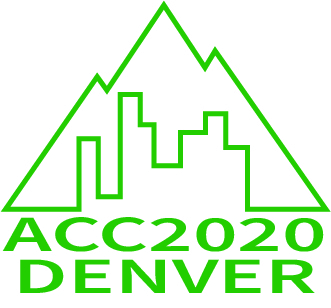Note that much of the information is still relevant even though we have transitioned to an online conference. For details about preparing your online presentation please visit the following link: http://acc2020.a2c2.org/online-video-presentation-format/ for information about preparing for your online presentation.
New to ACC 2020, some technical sessions will be organized as Rapid-Interactive (RI) sessions. The below is meant as an introduction to RI sessions and to help authors prepare for the conference.
What is an RI session? Each RI session will start with a 15 minute keynote (with questions), followed by 21 three-minute presentations given back-to-back without audience questions. After the talks, authors will go to an assigned digital LCD to present a digital poster during the interactive session where questions can be asked. This format enables authors to reach a greater audience (potentially more than 500 people) with their research while at the same time encouraging more in-depth individual interactions during the poster session.
More specifically, RI sessions will have the following format:
(a) Presentation Session: Total of 21 three-minute presentations are given back-to-back with no questions. Examples of presentations and instructions for authors are given below.
(b) Interactive Digital Poster Session: A 45-minute interactive session is held to enable author-audience interactions. Note that you are not required to print out any materials. LCD monitors will be available to display your poster (or other information). You may show a few additional slides with more details about your work. These slides can be created using Power Point, for example, and may include results in the form of videos, graphs, etc. After the presentation, authors will go find their paper number and LCD to connect their laptop to show additional slides for the interactive session. Attendees will walk around and interact with presenters to ask questions about their work.
What does this mean for RI presenters?
Presentation: Your RI presentation is only 3 minutes – this is strictly enforced. So, it is important to make sure you are conveying the most important aspects of your work to the audience. This means you may not have time to give a detailed literature review or all the details of every equation in your paper. It is suggested that you motivate your work and then focus on 1 or 2 main points (maybe a theorem and an experimental result). Your goal is to tell the audience why what you are doing is novel and cool to entice them to come talk with you during the interactive digital poster session after your “technical pitch talk”.
Tips:
- Practice your talk! You only have 3 minutes at which point you will be stopped. Shoot for 2 minutes 50 seconds to be sure. Time your talk and be prepared.
- Make sure you introduce yourself at the beginning of your talk since there will be no formal introductions.
- One way to treat this talk is like a marketing pitch. Try to get the audience excited about your work so they will come visit your digital poster afterwards.
Interactive Digital Poster Session: Directly following in the presentations, a 45-minute interactive poster session will take place. In general, preparation for this session is similar to a traditional poster session. You will not be required to print your poster as the conference will provide a 40” display or larger onto which you can project your laptop (VGA and HDMI connection provided). Thus, you will go find in the room the LCD with your paper number to connect your laptop to show additional slides for the interactive session. Attendees will walk around and interact with you to ask questions about your work.
Tips:
- Because of the digital display, you can incorporate videos and other moving examples to make your poster more exciting.
- Don’t spend all your time talking with one person. If someone is really interested, set up a meeting for later in the day.
- Perhaps bring two authors from the paper to the conference so one you will have time to look at other posters.
Presentation Logistics: Because of the rapid nature of the talks, there are some important presentation logistics to prepare for.


Fig. 1: Left: Example setup for a rapid talk. Right: Interactive digital poster session. You will be assigned an LCD monitor to plug in your laptop for displaying additional details of your work.
- AV Setup: The room will be set up with two identical podiums with a local monitor, computer hookups, a microphone, and a countdown timer. The single AV system (projector, speakers, and screen) will switch between the podiums every 3 minutes.
- Author Setup: During the presentation directly preceding your talk, you are expected to be setting up your computer on the podium not occupied by the current speaker. Even though the current speaker’s presentation will be projected on the main screen, the local monitor will display your presentation to make sure it is operating properly.
- Going Live: When the previous presenter’s 3 minutes is over, your presentation will be projected on the main screen, your mic will go live, and you should begin.
- Ending Your Talk: When your 3 minutes have expired, the next presenter will assume control of the AV system. You should quickly remove your computer for the next presenter.
Examples of RI talks are shown below:
